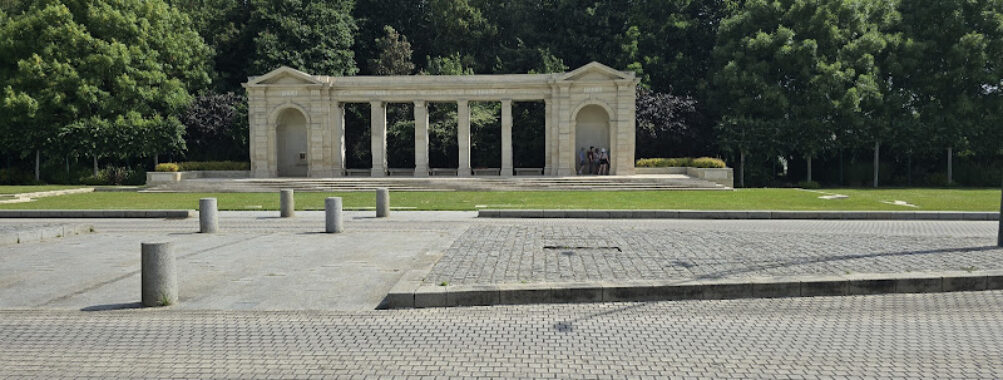
Bayeux War Cemetery
Table of Contents
Description
The Bayeux War Cemetery stands as a deeply moving testament to the sacrifices made during World War II, particularly during the harrowing days of the Normandy invasion. It’s not just a cemetery—it’s a quiet sanctuary where history breathes softly among the rows of white headstones, each marking a life cut tragically short. Established soon after the D-Day landings, this site has grown to become the largest Commonwealth cemetery in France, honoring nearly 6,500 soldiers who fought and died in the battle to liberate Europe.
Walking through the cemetery, you can’t help but feel the weight of the past mingling with the peaceful surroundings. The land itself was generously given by France to the United Kingdom as a symbol of gratitude and remembrance, which adds an extra layer of solemn respect to the place. The layout is meticulously maintained, with neat rows of graves set against lush, green lawns and mature trees that offer a gentle shade—perfect for reflection.
What strikes visitors most is the serene atmosphere. Despite the heavy history, there’s a quiet dignity here that invites you to pause, think, and remember. It’s not just about the numbers—over 4,600 graves are here, mostly soldiers who fell during the Normandy campaign—but about the individual stories behind each stone. Many of these young men were barely out of their teens, and it’s impossible not to wonder about the lives they might have led, the families they left behind, and the world they never got to see.
The Bayeux War Cemetery is also wheelchair accessible, with thoughtful provisions such as an accessible entrance and parking, making it easier for all visitors to pay their respects. It’s a place that encourages everyone to connect with history on a personal level, whether you’re a history buff, a family tracing roots, or simply someone seeking a quiet moment of remembrance.
Key Features
- Largest Commonwealth war cemetery in France, with nearly 6,500 burials
- Established shortly after the D-Day landings, preserving WWII history
- Beautifully maintained grounds with orderly rows of white headstones
- Wheelchair accessible entrance and parking for inclusive visits
- Located just outside the town of Bayeux, away from the hustle of big cities
- Adjacent to the Bayeux Memorial, commemorating over 1,800 missing soldiers
- Offers a tranquil environment ideal for reflection and remembrance
- Symbolizes the strong bond of gratitude between France and the Commonwealth nations
Best Time to Visit
If you want to experience the Bayeux War Cemetery at its most peaceful, aim for the shoulder seasons—spring or early autumn. The weather is generally mild, and you’ll avoid the summer crowds that flock to Normandy’s historic sites. I remember visiting in late April once, and the gentle blossoms combined with the calm air made the whole experience feel almost sacred.
Summer can be busy, especially around D-Day anniversary events in June, when many visitors come to pay tribute. While the atmosphere during those commemorations is powerful and deeply moving, it’s also a bit more crowded. If you’re after quiet reflection, midweek visits outside of peak holiday times work best.
Winter visits are less common, but they offer a stark, contemplative mood with fewer tourists. Just be prepared for colder weather and shorter daylight hours. No matter when you go, the cemetery’s solemn beauty and historical significance remain constant.
How to Get There
Reaching the Bayeux War Cemetery is pretty straightforward, especially if you’re already exploring Normandy’s WWII landmarks. It’s located just southwest of Bayeux town, on the D5 by-pass road, which is named Boulevard Fabian Ware—a fitting tribute to the founder of the Commonwealth War Graves Commission.
If you’re driving, the cemetery has its own parking area, including spots accessible for those with mobility needs. From Bayeux town center, it’s just a short drive or even a leisurely bike ride if you’re feeling adventurous and want to soak up more of the Normandy countryside.
Public transport options are a bit limited directly to the cemetery, so many visitors opt for guided tours or taxis from Bayeux or nearby Caen. The town of Bayeux itself is well connected by train and bus, making it a great base for exploring the region’s WWII sites.
Tips for Visiting
First off, take your time. This isn’t a place to rush through. Give yourself at least an hour to wander the grounds, read some of the inscriptions, and soak in the atmosphere. You might find yourself reflecting on the enormity of the conflict and the personal stories hidden behind each headstone.
Bring a notebook or your phone to jot down any names or details that catch your eye. Sometimes, learning about a particular soldier’s story can make the experience more personal and memorable. And if you’re into photography, the soft natural light in the mornings or late afternoons really highlights the serene beauty of the site without feeling intrusive.
Respect is key here. It’s a military cemetery, after all, so keep noise to a minimum and follow any posted guidelines. But don’t be afraid to feel whatever emotions come up—whether it’s sadness, gratitude, or awe. That’s part of what makes a visit so impactful.
Lastly, consider pairing your visit with a stop at the nearby Bayeux Memorial, which honors those Commonwealth soldiers who have no known grave. It’s just across the road and adds another layer to understanding the scale and sacrifice of the Normandy campaign.
Visiting the Bayeux War Cemetery is more than just a sightseeing trip—it’s a chance to connect with history on a deeply human level. You don’t have to be a history expert to feel its power. Just bring your curiosity, an open heart, and maybe a little bit of quiet respect. It’s a place that stays with you long after you leave.
Location
Places to Stay Near Bayeux War Cemetery
Find and Book a Tour
Explore More Travel Guides
No reviews found! Be the first to review!